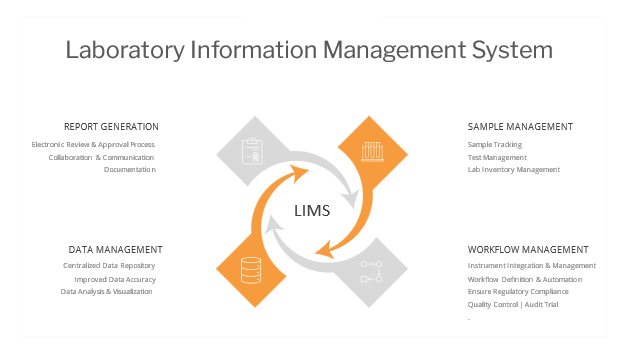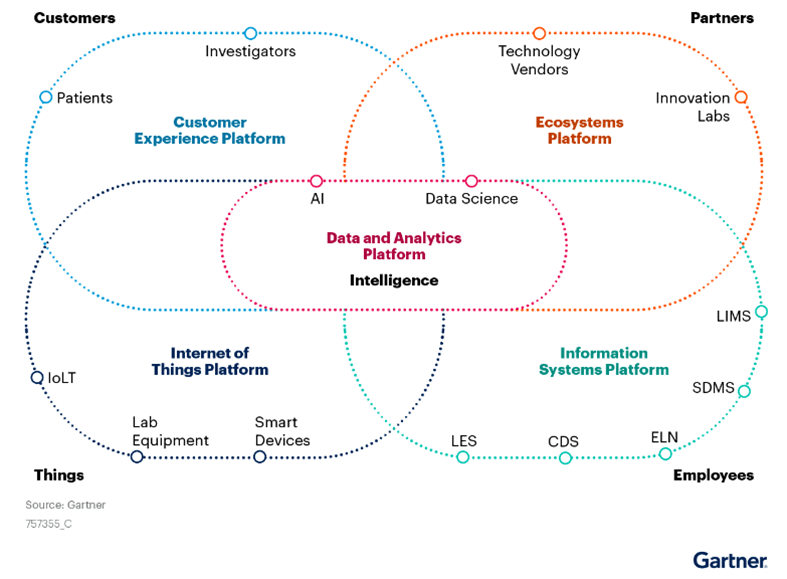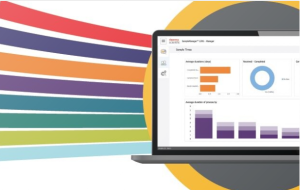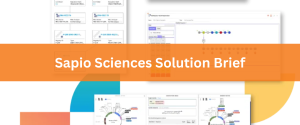The LIMS Guide
Astrix is the global leader in LIMS Services. We bring our unique, technology and process agnostic approach to nearly all of the leading life science companies worldwide. Our expertise is extensive across the industry – working with the leaders in laboratory technologies such as LIMS, ELN, data transformation, AI and more!
We’ve create this LIMS Guide to be a living resource for you to learn about technology trends driving laboratories towards digital transformation and towards a lab of the future.
Connect with a LIMS Expert
The Ultimate Guide to LIMS in the Digital Lab of the Future
In today’s rapidly evolving life sciences landscape, it is essential for lab professionals to leverage innovative tools and technologies that can enhance their effectiveness and productivity. In the Digital Lab of the Future, LIMS plays a key role in enabling lab operations to become more streamlined and data-driven, keeping up with the growing demands on time and resources. This ultimate guide to LIMS will equip lab professionals with the knowledge of its concept, implementation, and application, enhancing lab operations to align with future goals and regulatory requirements.
What is a LIMS?
LIMS, or Laboratory Information Management System, is a software-based solution designed to help labs store, manage, and access their data efficiently. It has become an integral part of modern lab operations. But what exactly is LIMS? How does it streamline the process of data management? Let’s dive in to better understand this powerful tool.
How and Why is a LIMS Used?
LIMS provides a centralized platform for managing laboratory data, which includes sample tracking, inventory control, and storage of analytical results. This allows labs to enhance their operational efficiency and accuracy while reducing the potential for human error. Apart from these core functionalities, LIMS systems often include specialized features such as Sample Management (SDMS), Electronic Laboratory Notebook (ELN) integration, Quality Control (QC) tracking, and Reporting capabilities. These features are critical in ensuring compliance with regulatory requirements, as well as facilitating data analysis and interpretation. Moreover, LIMS systems can be tailored to meet the requirements of various lab settings such as clinical, research, or production environments.
The primary role of a LIMS within a lab is to streamline and enhance the management of lab operations and data. Its key functionalities include:
- Provides a centralized repository for easy access to data.
- Enables management and automation of workflows.
- Connects with various systems, instruments, and devices.
- Performs instrument run monitoring.
- Keeps track and manages samples, lots, reagents, and associated test data.
- Ensures support with regulatory compliance & creates audit trails.
- Allows for the visualization and analysis of data.
- Simplifies the process of report creation, review, and approval.
The incorporation of LIMS is now essential in modern lab management. It streamlines operations, increases throughput, promotes data integrity, provides real-time analytics, fosters teamwork, and ensures regulatory compliance.

Call On Astrix
Need help with a new or existing LIMS or ELN Project? Need upgrades, training, validation, managed services? Call on the trusted leaders and LIMS experts who support the majority of top Life Science and Pharmaceutical companies globally!
Click the button below and complete our LIMS Service Request form.
LIMS Solution Providers in the Global Marketplace
LIMS solution providers are emerging as a driving force in the global marketplace. This is primarily due to the greater emphasis on digitalization, data management and analysis, and the exponential growth of scientific data. Researchers, scientists, and lab technicians rely heavily on LIMS for centralized data management, workflow optimization, and data security. In addition, the increasing demand for more innovative, comprehensive, and fully customizable LIMS solutions has led to the rise of specialized LIMS solution providers worldwide. As a result, modern LIMS solutions offer greater flexibility, scalability, and powerful features that can integrate seamlessly with lab equipment and software, offering an unparalleled level of data management and analytics to achieve your Lab of the Future.
Astrix Supports a variety of solutions for its clients including Biovia, ThermoFisher SampleManager, Benchling, StarLims, Wters, Labvantage, CloudLIMS, Agilent, l7Informatics, Sapio, Eusoft and more.

CLICK HERE to Visit our Technology Partner Page to learn more about LIMS Vendors that we work with
Digital Lab of the Future requires Lab Related Information to Flow Across Different Platforms and be Leveraged Using New Entities and Business Processes

Emerging technologies are continuously shaping the life sciences digital landscape. Understanding how to prioritize these platforms and map them specifically to your unique lab environment can be quite an undertaking. From assembling a capable team, and engaging with executive peers for prioritization, to ensuring each digital transformation initiative delivers incremental optimization results, enlisting the support of an expert consultant can help you efficiently and effectively navigate this digital alignment journey.
The Top 10 Benefits of a LIMS
As innovation redefines the landscape of scientific research, lab workflows must adapt and keep pace with these perpetual changes. Incorporating digital technology is a crucial step toward maximizing accuracy, efficiency, and productivity. With the rapid evolution of technology, LIMS has become increasingly important in reshaping the lab environment to maintain its applicability in a progressively tech-driven digital future.
Here are the top 10 benefits of implementing a LIMS and how it can revolutionize your lab operations and radically transform how modern labs function, boosting data integrity, improving tracking and reporting capabilities, and optimizing resource allocation.
- Centralization of Data: LIMS provides a centralized database for storing and tracking laboratory data. This streamlines data management, ensuring accuracy, consistency, and easy accessibility of information.
- Improved Efficiency: LIMS increases the efficiency of a lab by automating complex processes, maximizing the use of resources, and reducing manual errors.
- Enhanced Data Management: LIMS allows for easy storage, access, and retrieval of data, making tasks such as data analysis, comparisons, and interpretation easier and more accurate.
- Increased Accuracy: LIMS automates the generation of samples and results, reducing the potential for human error, and enhancing the accuracy of your data and results.
- Compliance Management: By ensuring that important audits and quality assurance tests are appropriately tracked and documented, LIMS assists labs in complying with various regulatory authorities.
- Scalability: LIMS is a scalable solution that can grow or reduce in sync with the needs of the laboratory.
- Security: LIMS helps to maintain data integrity by ensuring that only authorized users can access specific data, thereby minimizing data breaches or loss.
- Cost & Time Efficiency: Through the automation of routine and manual tasks, LIMS helps in cutting down labor expenses and errors, resulting in substantial time and cost savings. This enables staff to focus more on the primary research tasks.
- Enhanced Collaboration: With LIMS, data can be shared easily amongst team members leading to better collaboration and increased productivity.
- Streamlined Workflow: LIMS helps to streamline workflow by tracking samples at all stages, from the time they arrive through, processing, storage, and dispatch.
A properly implemented LIMS system offers multiple advantages to labs, including enhanced data entry accuracy, convenient retrieval of stored data, adherence to regulatory requirements, and optimized workflows for lab personnel. By using a LIMS, labs can attain increased consistency, efficiency, and accuracy in their operations, thereby improving the quality of their scientific results.
Read the Top Blog in the LIMS Industry
Below are some of our most popular blog articles we’ve written over the years! Boost your LIMS knowledge with our LIMS Blog Archive below

From Legacy Systems to the Digital Lab of the Future
Transforming Lab Operations for Smarter, Scalable Science to achieve a Digital Lab

FDA Modernization Act 2.0: Accelerate Readiness with an Advanced LIMS Solution
In April 2025, clinical research reached a turning point, with advances reshaping

Decommissioning and Migration of LIMS: A Structured Approach
Astrix LIMS Blog – Decommissioning and Migration of LIMS: A Structured Approach to ensure a successful project

Optimize Lab Efficiency Through Integrated Data Management with SampleManager LIMS version 21.3
Vendor Insights: Thermo Scientific SampleManager LIMS version 21.3 Accelerating Scientific R&D with

Solution Brief: Astrix & Sapio Sciences
Overview: Delivering Seamless Lab Operations and Data-Driven Discovery Astrix and Sapio Sciences

Key Laboratory KPIs and Lab Metrics Tracking Made Easy with a LIMS
You can’t improve what you don’t measure, and this cuts across industries.

Using Labvantage LIMS to Prepare your Lab Informatics Data for AI
Life science labs are rapidly evolving to meet new scientific challenges, driven

Lab Informatics Tech Debt: How to Manage and Minimize It
What Is Tech Debt in Lab Informatics—and How Does It Happen? Technical
Industry trends to Follow in Lab Technology
New technologies and changing industry trends have brought about significant enhancements in LIMS capabilities, ranging from AI and automation to cloud-based solutions, mobile technologies, advanced data analytics, and heightened data security. LIMS providers are increasingly adopting a user-centric approach, powering the digital lab of the future through user-driven interface advancements.
Scalability and sustainability also remain a key focus as labs continue to expand operations and seek ways to reduce their environmental footprint. Listed below are the top ten industry trends in LIMS solutions, highlighting their impact on lab operations and the future direction of this critical technology.
- Cloud-Based Solutions: In response to the growing need for data accessibility and remote work capabilities, providers are enhancing their offerings with cloud-based solutions. They enable secure, 24/7 access to lab data from anywhere and reduce the burden of IT management.
2. Integration Capabilities: LIMS solutions that seamlessly integrate with other laboratory and business systems, lab equipment, and technologies, streamline processes and operations. Connectivity platforms facilitate data exchange across the lab enterprise.
3. Data Analytics and AI: Given the increasing importance of big data in science and business, many LIMS providers are incorporating advanced analytics, AI, and machine learning capabilities into their solutions.
4. Regulatory Compliance: LIMS providers also integrate capabilities to fulfill various industry-specific regulatory requirements, including GLP, GMP, ISO, FDA, and others, assisting laboratories in audit and compliance tasks.
5. Mobile Capabilities: As labs and researchers seek greater flexibility, LIMS solutions that offer mobile capabilities are on the rise enabling access and data input on the go, directly from the field or remote locations.
6. User-Driven Enhancements: Providers focus more on end-users, designing more intuitive and customizable interfaces and workflows.
7. Sustainability: With increased environmental concerns, providers are making an effort to create solutions that can help reduce waste, optimize energy use, and assist companies in their sustainability goals.
8. Scalability: LIMS providers are designing solutions with flexible scalability to accommodate lab workflows as they expand or consolidate operations.
9. Data Security: With cyber threats on the rise, LIMS providers focus on enhancing data security, and ensuring the protection of critical lab and business data.
10. Automation Capabilities: With the trend towards automation and high-throughput processes, providers are developing cost-effective solutions to optimize efficiency, quality, and safety.
These trends, when incorporated, facilitate the free flow of information throughout the lab ecosystem. They are designed to increase the precision, speed, safety, and accuracy of lab processes, while simultaneously decreasing operational costs and time.
LET´S GET STARTED
Contact us today and let’s begin working on a solution for your most complex strategy, technology and strategic talent services.
CONTACT US